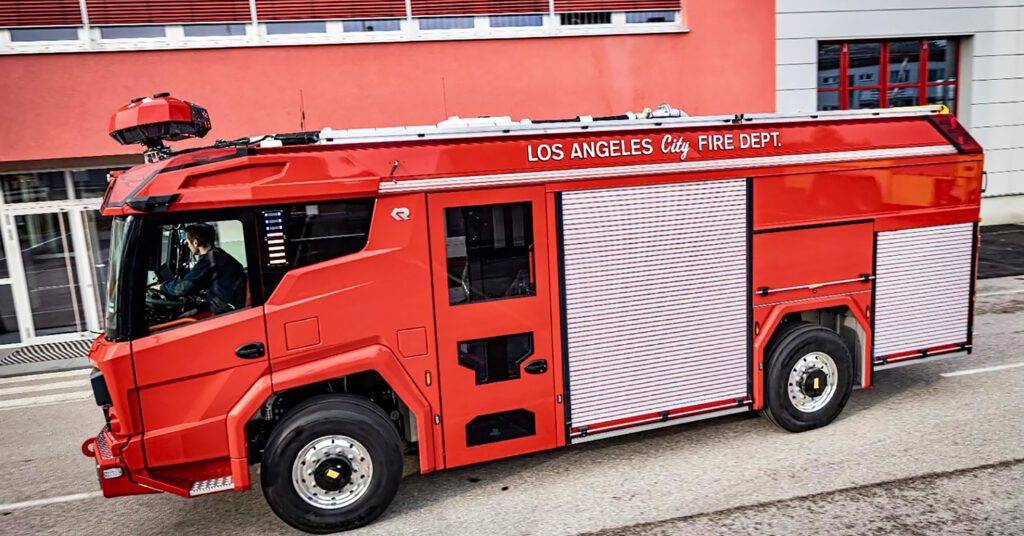Los Angeles firefighters will soon be putting out flames in a new, sustainable ride. The city is set to debut the country’s first-ever electric fire truck. And it looks like something straight out of Transformers. The new, planet-friendly, firefighting truck is a shining example of Los Angeles’ larger goal of a clean energy future. But is LA’s transition to zero-emissions transportation happening quickly enough?
Electric fire truck takes LA
Gas-powered fire trucks’ days in LA may be numbered. The city’s new electric fire truck is slated to take to the streets of the City of Angels in May.
“Take a look at our new #LAFD electric engine,” LA Fire Chief Ralph Terrazas, who is set to retire on March 26, tweeted. “It’ll be the 1st in the Nation!”
The Los Angeles Fire Department (LAFD) ordered the plug-in hybrid truck from Austrian-based fire truck manufacturer Rosenbauer in February 2020. It will be assigned to Hollywood’s Fire Station 82, which Terrazas explained would be advantageous due to the area’s brush fire threats and heavily congested, tight roads. “The Rosenbauer has a very tight turning radius,” he said. “It accelerates unbelievably—much faster than our current apparatus.”
The truck is the fourth of its kind, following similar electric fire engines in Berlin, Amsterdam, and Dubai. Rancho Cucamonga, a city in Southern California, has also ordered a Rosenbauer, which is expected to be delivered in late 2023.
“The electric fire engine is an innovative tool that will help reduce noise and harmful diesel emissions while providing a flexible tool for firefighting and rescue operations from a technologically advanced platform,” Terrazas said. “We are looking forward to evaluating it in a real-world environment once it hits the streets of Hollywood.”

Is LA’s clean energy future achievable?
California’s transportation sector accounts for more than half of all greenhouse gas emissions in the state.
In September 2020, Governor Gavin Newsom announced that the state would phase out gas-guzzling cars in favor of zero-emission vehicles to help fight the climate crisis. By 2035, all new cars and passenger trucks sold in California must be emissions-free. “This is the most impactful step our state can take to fight climate change,” Newsom said at the time. (The announcement is in line with a similar executive order by President Joe Biden, which stipulates that half of all new car sales must be zero-emission by 2030).
Notorious for its bumper-to-bumper traffic and heavy smog, LA is on a mission to go all-electric. This is good news, considering it has the worst air quality out of any city in the nation. In 2019, Mayor Eric Garcetti launched LA’s Green New Deal, which builds onto the city’s 2015 Sustainability Plan.
The plan outlined goals to make LA carbon neutral by 2050, including making all major renovations and new municipally-owned buildings all-electric, phasing out plastic straws and single-use containers by 2028, not sending any trash to landfills by 2050, and recycling 100 percent of the city’s wastewater by 2035. It’s ambitious, to say the least.
The Green New Deal also solidified the city’s position as a “national leader” in electric vehicle (EV) infrastructure. The city’s government vehicles are going all-electric by 2028. It’s pledged to purchase only zero-emission buses after 2025. In October 2021, the city debuted its first zero-emission Metro bus line, the Metro G (Orange) Line—which took five years and $80 million to complete. The city aims to launch 28,000 more electric charging stations by 2030.

A (conclusive) roadmap to electrification
Over the years, the city of LA has outlined many (many) goals for achieving zero emissions, leading two local councilmembers to call for a more unified roadmap towards electrification.
In August 2021, LA City Councilmembers Paul Krekorian and Mitch O’Farrell noted their concerns that the city’s electric transportation goals were fragmented and inefficient in the overall fight against the climate crisis. They introduced a motion for a master plan to transform the city to 100 percent renewable energy by 2035 (the city previously set a deadline of 2045) and achieve zero emissions.
“Meeting our climate goals requires urgent action and a broad-based approach,” O’Farrell said. “We have a golden opportunity to work with the Biden administration on our shared objectives for a sustainable and clean energy future. The sooner we transition to all-electric vehicles, the sooner we clean the air in Los Angeles. For that reason, incentivizing electric vehicle use in Los Angeles is arguably our top environmental priority.”
In a move to clean energy, the city will undoubtedly need a bigger power grid. (And it’ll need to ensure charging points are sustainably powered.) It must also address the fact that EVs still aren’t accessible to all. A 2021 report by The International Council on Clean Transportation indicates that “the transition to zero-emission vehicles can be enabled by supporting infrastructure, incentives, and local policies to overcome electric vehicle barriers to ensure equitable zero-emission mobility access to all Angelenos.”
But the electric fire truck is a step forward in the city’s goal of electrification. “The new electric engine is an excellent platform for the LAFD to test the future of alternative fire engines and allows the department to pursue a green path forward, as outlined and championed by Mayor Eric Garcetti,” said Cheryl Getuiza, LAFD’s government affairs and public information director.


